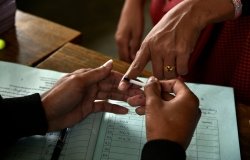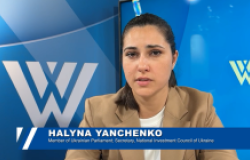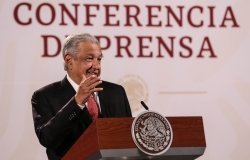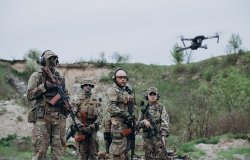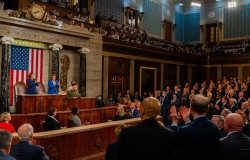The FBI: Making Real Change in a Virtual World
Probably at no time in history has the FBI changed on such a large scale as in the past three-and-a-half years. In this Director's Forum, FBI Director Robert Mueller outlined these changes in light of ever evolving threats.
It is a pleasure to have the opportunity to speak to members of the Woodrow Wilson International Center. In the tradition of Woodrow Wilson, I will not to speak for long. Apparently, while he was President, one of his Cabinet members praised his short speeches and asked how long it took to prepare them. "It depends," Wilson told him. "If I am to speak 10 minutes, I need a week for preparation; if 15 minutes, three days; if half an hour, two days, if an hour, I am ready now." Well, I prepared for about two and-a-half days, just to give you an indication of what you are in for.
There is another story about one of Wilson's predecessors. When he was still vice president, Teddy Roosevelt went hiking in the mountains of New York. After stopping for lunch, he saw a messenger headed his way. The man brought Roosevelt a telegram that said President McKinley was gravely ill and that he should depart for Buffalo immediately. The vice president was 50 miles from the nearest railroad station and 10 miles from the nearest telephone. Walking and riding through the night, he finally made it to the train station, where he learned that McKinley had died and he was now president of the United States.
Obviously, information was not easily or rapidly shared in those days. Contrast that with news of the recent death of Pope John Paul II in Rome, spread throughout the world by text messaging and television satellite in a matter of seconds.
In the last hundred years, sweeping social, political, and economic changes have taken place across the globe. Many of you may be familiar with Tom Friedman's book, The Lexus and the Olive Tree and may be reading his latest bestseller, The World is Flat. In them, he describes the impact of globalization on the world economy. That same globalization has also impacted law enforcement.
Because of these global changes identified by Friedman and others, it was clear even before 9/11 that the FBI needed to change. Once America was attacked, we needed to change overnight. Immediately, our number one priority became preventing another attack.
Probably at no time in history has the FBI changed on such a large scale as in the past three-and-a-half years. Today, I want to discuss these changes in light of evolving threats and improvements in our ability to respond to those threats, both old and new.
The FBI has always changed to meet evolving threats — from the "gangster era" through the Cold War. It was because crime had begun to cross state lines that the Bureau of Investigation was first established in 1908, under then President Theodore Roosevelt.
Nearly 100 years later, criminal activity not only crosses state lines, it traverses international boundaries with the stroke of a computer key. Crime is more diverse than ever before. It includes terrorism, violent gangs, illegal weapons trade, and the trafficking of human beings.
Furthermore, the threat is increasingly asymmetrical and complex. Our adversaries may be nation states, militaries, or international terrorist or criminal organizations. They are dedicated to stealing our secrets, and some are dedicated to destroying our way of life.
To continue preventing attacks in the future, we must anticipate the challenges we will face down the road.
Amongst these challenges are advances such as high speed technology, miniaturization, and unlimited bandwidth that will allow information to be transferred much more easily. As Friedman would point out, that will be good for the world economy -- but it will also provide opportunity for criminals.
It is likely that the role of nation-states will continue to diminish. The implication is that criminals will seek operational advantages and sanctuary through hidden networks that are difficult to identify and penetrate, and that easily cross jurisdictional boundaries.
Global and demographic changes may lead to large numbers of unemployed, dissatisfied young people and create breeding grounds for terrorists. We may see shortages of resources such as oil, food, and water; creating a more hostile world. Beheadings in Iraq and terrorists targeting a school in Russia suggest an escalating hierarchy of terror.
When confronting these new threats, the question becomes how do we respond as an organization? Our ability to preempt another 9/11 or Oklahoma City bombing will depend on our ability to predict an attack. It requires three critical capabilities: intelligence, technology and partnerships.
First, intelligence. Intelligence is simply information. For our purposes, intelligence means vital information about those who would do us harm. The FBI has always used intelligence in pursuing its criminal cases. It is how we fought Nazi spies during World War II, Soviet espionage during the Cold War, and La Cosa Nostra in the seventies and eighties.
Over the years, though, walls — both real and perceived — prevented the sharing of intelligence and criminal information. Since 9/11, the single most important change in our ability to fight terrorism has been the Patriot Act, which removed the legal walls between intelligence operations and criminal investigations.
This means that law enforcement and intelligence agents are now able to legally coordinate terrorism investigations. The FBI and CIA now work together side-by-side. The FBI can now analyze intelligence and integrate that analysis into all investigative programs — counterterrorism, counterintelligence, criminal, or cyber. Because we can take a wider view, we often see links between criminal and counterterrorism cases.
For example, one terrorism case initiated in Minneapolis became a criminal case in San Diego. The investigation focused on a group of Pakistan-based individuals who were involved in arms trafficking as well as drug distribution. They had also discussed an exchange of a large quantity of hashish and heroin for four stinger anti-aircraft missiles to be used by Al Qaeda in Afghanistan. The operation resulted in the arrest, indictment, and subsequent deportation of all three individuals from Hong Kong to San Diego to face drug charges and charges of providing material support to Al Qaeda.
Here was a case where intelligence, shared among agencies, exposed the interplay of criminal and foreign intelligence activity.
To improve our intelligence capabilities, we have established one comprehensive program under the Directorate of Intelligence with oversight and budget authority over all FBI intelligence activities. The Directorate is able to leverage the core strengths of law enforcement — with its attention to the pedigree of sources and fact-based analysis — while ensuring that information is shared by those who collect intelligence, those who analyze intelligence, and those who must act upon intelligence to protect our nation.
We have also created intelligence groups in every FBI field office nationwide. Analysts, agents, linguists and surveillance specialists work as teams gathering, analyzing, and disseminating intelligence information.
These Field Intelligence Groups are at the center of our intelligence operations. They have a major role in ensuring that we gather what we need to know, and that we share it with our counterparts in law enforcement and with the intelligence community.
Let me add that we are currently reviewing the recommendations of the WMD Commission. As you know, the Commission recently completed its report and offered a number of recommendations for the FBI and the rest of the Intelligence Community. The Commission's work makes a significant contribution to understanding ways in which we can improve our intelligence capabilities. We are looking forward to continuing to build and reform our national security program in light of the Commission's recommendations.
We look forward to working with the new Director of National Intelligence, John Negroponte, to ensure that the intelligence we collect meets established requirements and that our intelligence agencies work together effectively.
The second critical capability — technology — helps us collect, analyze, and share intelligence. Or in other words, know what we know. Agents and intelligence analysts will continue to need new tools and capabilities. It does not take long for terrorists to catch on to our technology and to adjust. In the future, our technology must be upgraded on a continual basis so that we stay ahead of our enemies.
We will need a fully operational modern information technology infrastructure. One that enables effective information sharing that will close the communication gap with our law enforcement partners and the intelligence community. Our overriding goal is to provide the right information, to the right people, at the right time.
We have dramatically upgraded our technology since 9/11, particularly when it comes to replacing computers, updating our networks, and developing databases. We have had disappointments along the way, but we are continuing to adjust our strategy to incorporate the most modern technology into every aspect of our operations.
To help ensure our technology is cutting-edge, we consulted with a broad range of industry leaders to help bring our capabilities up to where they should be.
We currently have a project to upgrade our software on the drawing board. We anticipate it will be done in four phases, each of which will deliver new capabilities. We will use this new program to transform the FBI's application platform and conduct an incremental replacement of all our legacy applications to bring the Bureau in line with our new Enterprise Architecture.
We have also taken steps to ensure appropriate management of our IT projects. Our Chief Information Officer now has global command and control of our IT, including operations and funding. In addition, we have implemented a process to ensure that all projects are carried out according to industry best practices.
This is how we are internally transforming our infrastructure. Meanwhile, externally, our operational technologies are growing every day.
One way we are using technology to build connections is the National Law Enforcement Data Exchange system, known as N-Dex. When complete, this will be the first national information sharing service. It will collect and process structured crime data – similar to an index card – from all major FBI databases. For the first time, the FBI will be able to provide "one stop shopping," where combined data can be correlated. This will provide access to information allowing us to detect and prevent terrorism attacks, link cases, and form broader investigative partnerships.
As a complement to N-Dex, Regional Data Exchanges will enable the FBI to participate regionally with federal, state, tribal, and local law enforcement agencies around the country. These systems will allow the sharing of full text information on a regional basis. It will provide the analytic piece needed to search and correlate unstructured data from regional systems.
In addition to intelligence and technology, the third critical element to improving our capabilities is partnerships. Partnerships at all levels — local, state, federal, and international — help us share what we know.
At the state and local level, our Joint Terrorism Task Forces are the eyes and ears of communities around the country. Working side-by-side, members from intelligence and law enforcement, track down each and every counterterrorism lead, no matter how insignificant it may seem. In the last three years, we have increased the JTTFs from 35 to 103.
In addition to the JTTFs, our Regional Computer Forensics Labs combine partnerships and technology. These state-of-the-art regional facilities are highly specialized laboratories that provide forensic examinations of digital evidence. Six labs are up and running, and eight more are in the works. In each one, law enforcement agencies from all levels of government train, work, and share information together. In particular, they make use of new forensics capabilities to address terrorism, cyber crime, identity theft, as well as other crimes.
Not only are we cooperating better at the state and local level, we are also working more closely with our partners at the national level. To ensure we all have access to the same information, we have created a number of "fusion centers." At the National Counterterrorism Center — formerly TTIC — federal agencies work side-by-side analyzing terrorist threat information. The Center receives foreign intelligence information lawfully collected by its members. This includes international terrorism information collected by the law enforcement community.
Cooperation has improved globally as well. FBI Agents are working with our law enforcement partners from Rome to Romania. We are gathering intelligence in Iraq and Afghanistan. These international partnerships are critical if we hope to be successful in the future.
Today, cases with an international nexus have become the rule rather than the exception. President Wilson could have been talking about law enforcement today when he said, "Friendship is the only cement that will ever hold the world together."
The FBI now has offices across the globe. Our 51 Legal Attaché offices have become increasingly important to our operations. What began primarily as a liaison office, now assists our counterparts overseas on joint investigations, intelligence-sharing, and the development of new methods to prevent attacks.
One example of a terrorism investigation aided by international cooperation is the investigation into the Lackawanna terrorist cell outside Buffalo, New York. From the police officers who helped to identify and conduct surveillance on the cell members. To the information obtained from sources overseas. To the diplomatic and intelligence personnel who coordinated our efforts with foreign governments. To the FBI agents and federal prosecutors who conducted the investigation leading to the arrests and indictment. Each had a significant role.
In this era of globalization, working side-by-side is not just the best option, it is the only option.
By building our intelligence capabilities, improving our technology, and working together, we can and we will develop the capabilities we need to succeed against the threats of the future.
I have discussed some of the changes we have made, but I want to finish with two strengths of the FBI that should remain the same. One is our values. These values include respect for the authority granted to us and strict adherence to the United States Constitution. They are also reflected in our motto: Fidelity, Bravery, and Integrity.
The other is the FBI's commitment to protecting our civil rights. The men and women who serve in the FBI are fully engaged in the fight against terrorism and crime. They are working day and night to protect the American people, while upholding the civil liberties we cherish. We have made progress. We will continue to meet — and to defeat — threats against the security of this nation and the world.

